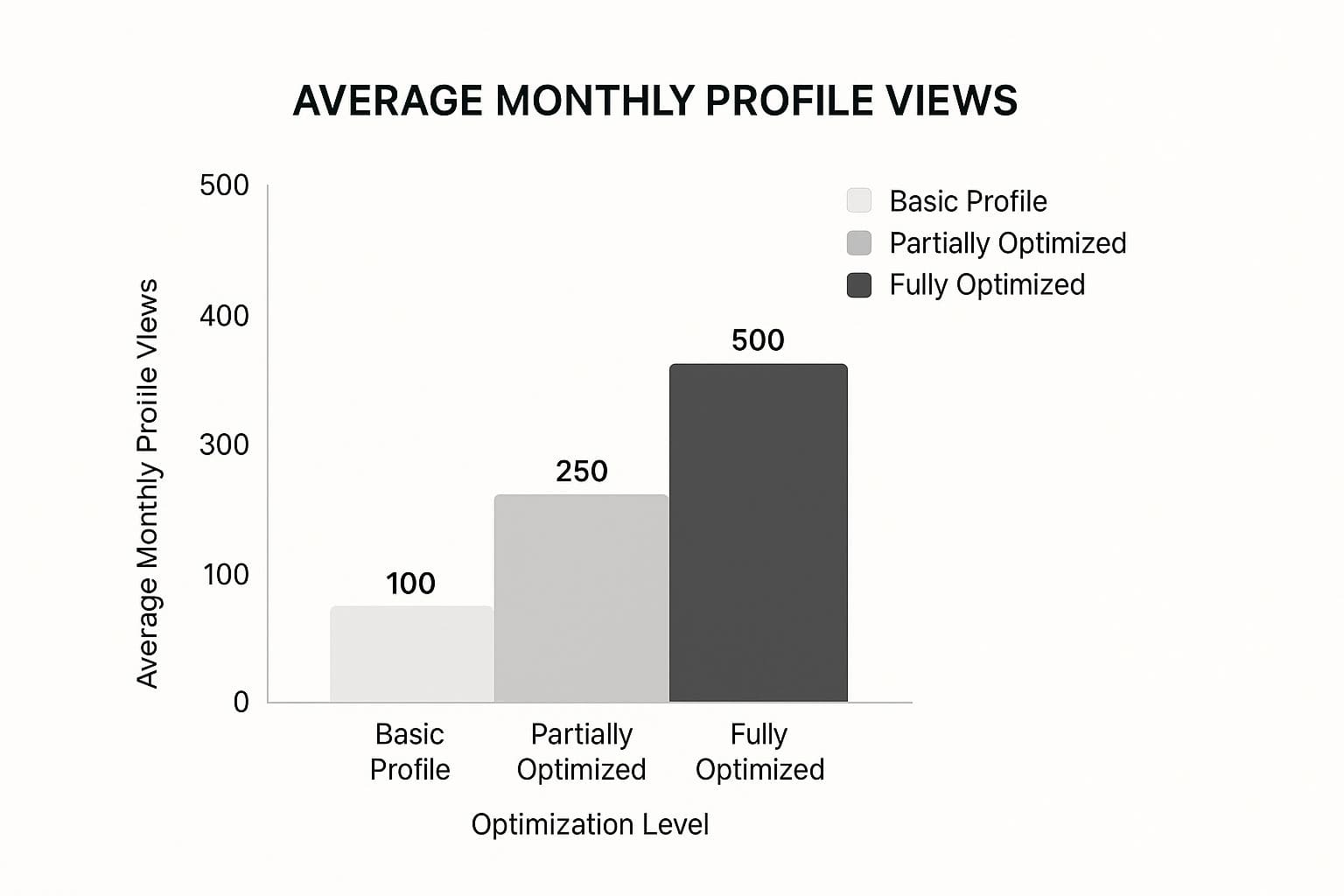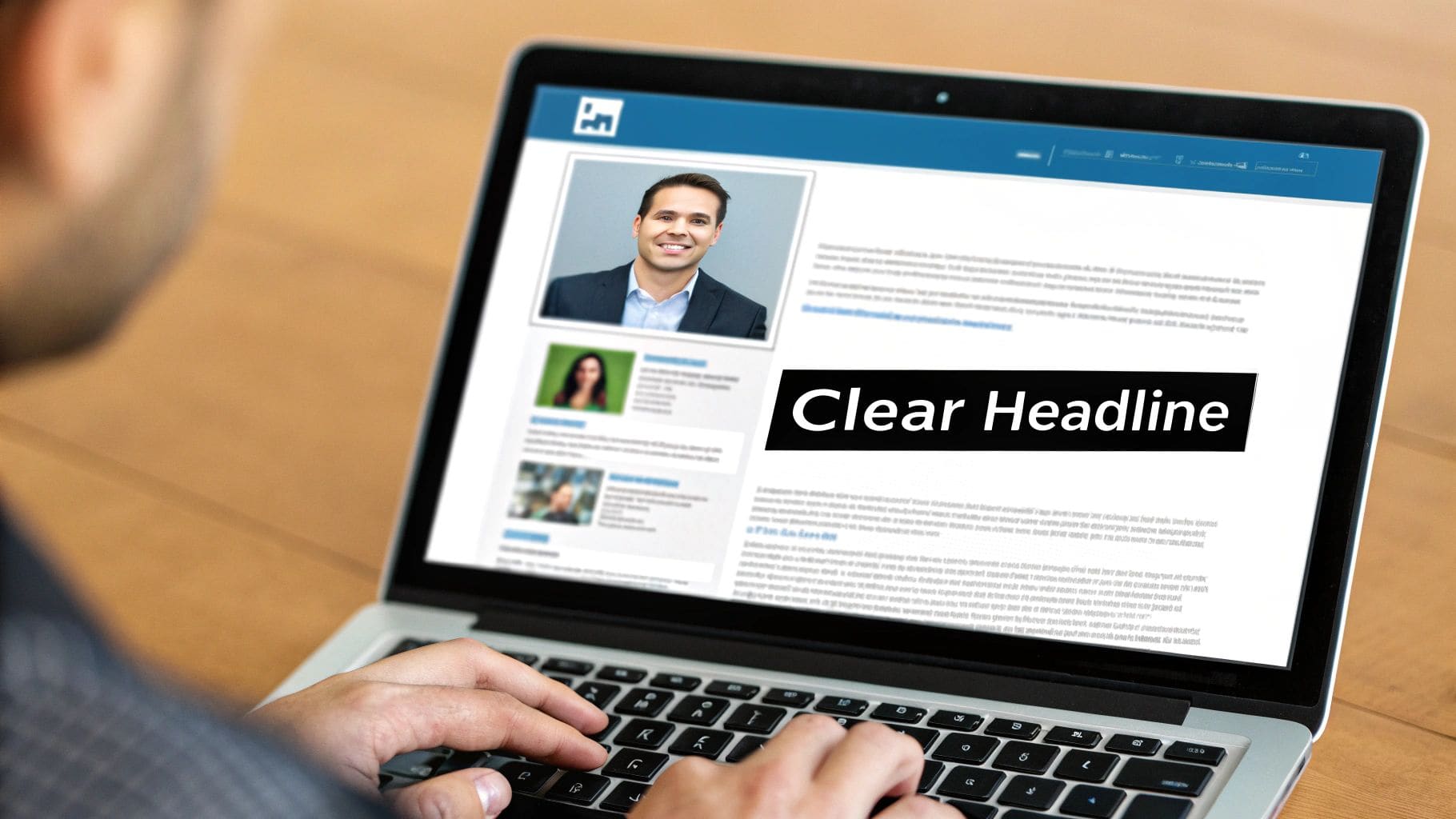How to Optimize Your LinkedIn Profile for Tangible Results
Learn how to optimize your LinkedIn profile with expert tips on headlines, summaries, and experience to attract recruiters and new opportunities.

How to Optimize Your LinkedIn Profile for Tangible Results
Optimizing your LinkedIn profile isn’t just about filling in the blanks. It’s about strategically turning each section—from your photo and headline to your experience and skills—into a magnet for recruiters and the right kind of connections. This guide will give you actionable steps to use the right keywords, showcase your achievements with hard numbers, and tell a professional story that generates real opportunities.
Crafting Your First Impression
Your profile photo and headline are your digital handshake. In the split second it takes someone to glance at them, they decide whether to scroll on by or click to learn more. These two elements are absolutely critical for making an immediate, positive impact. Let's move past the generic advice and get into what actually works.
Choose a Photo That Builds Trust
Your profile picture does more than just show what you look like; it communicates confidence and approachability. Think of it as the first step in building trust with a potential employer or client. A grainy selfie or a cropped photo from a wedding just won't cut it. It sends the wrong message.
Actionable Outcome: Take a high-quality headshot where your face takes up at least 60% of the frame. Practical Example: Stand facing a window for soft, natural light, and use your phone's portrait mode against a simple, uncluttered background like a plain wall or a blurred-out office setting. Your expression should be warm and engaging—a genuine smile makes you seem instantly more approachable.
The data backs this up. Profiles with a professional photo get up to 14 times more views. It’s a clear signal of how much recruiters value that visual first impression. If you're curious, you can dig into more LinkedIn statistics to see the full picture.
Write a Headline That Sells Your Value
Your headline is your personal elevator pitch, and it’s some of the most valuable keyword real estate on your entire profile. The default for most people is just their current job title, like "Marketing Manager." That’s a huge missed opportunity. A truly effective headline tells people who you help and the results you deliver.
A simple formula I often recommend is: [Your Role/Expertise] | [Value Proposition/Who You Help] | [Keyword/Specialty].
Let's look at how this plays out in the real world.
Headline Optimization From Generic to Magnetic
A generic headline is forgettable. An optimized one starts a conversation. This table shows you how to make that switch.
| Generic Headline | Optimized Headline | Why It Works |
|---|---|---|
| Project Manager | Senior Project Manager, PMP | Delivering Complex Tech Projects on Time & Under Budget | SaaS & Agile Methodologies | It’s packed with keywords (PMP, SaaS, Agile), quantifies value (on time & under budget), and specifies industry expertise. |
| Content Writer | Freelance Content Writer for B2B Tech | Crafting SEO-Driven Articles That Convert Leads | FinTech & AI | This clearly defines the target audience (B2B Tech), states the outcome (convert leads), and lists valuable specializations (FinTech, AI). |
Your headline should work like a mini-advertisement for your career. It needs to be compelling enough to make someone stop scrolling and think, "This is the person I need to talk to."
This isn't just theory. The impact of a fully optimized profile is massive.

As you can see, a fully optimized profile can pull in five times more views than a basic one. More views directly translate into more messages, more connections, and more opportunities.
Telling Your Professional Story

So, your headline did its job and stopped the scroll. Now what? The "About" section is your chance to connect the dots and give that first impression some real substance. This isn't just a space to copy-paste your resume summary. It’s where you tell your story, weaving together your experience and personality in a way that resonates with people and plays nice with LinkedIn’s algorithm.
Think of it as the cover letter for your entire professional brand. A great summary can be the difference between a profile skim and a genuine connection request. You want to make it ridiculously easy for a recruiter or potential client to grasp who you are, what you’re great at, and why they should care.
Hook Them From the First Sentence
You’ve got about three lines before LinkedIn hides the rest of your summary behind a "see more" link. Those first few words are everything. They need to pack a punch and make someone curious enough to click.
Forget the generic openers like, "Seasoned marketing professional with over 10 years of experience." It's a snoozefest. Start with a bold statement about your mission, a standout achievement, or the core problem you exist to solve.
- Practical Example (Sales Leader): "I build and scale high-performing sales teams that consistently blow past revenue targets in the crowded SaaS world."
- Practical Example (UX Designer): "My obsession is turning messy user problems into simple, beautiful, and intuitive digital experiences."
See the difference? You’re not just stating a title; you’re declaring your purpose. This immediately frames your expertise and gives the reader a reason to keep going.
Detail Your Expertise with Tangible Results
Once you've got their attention, the middle of your summary is where you back it all up. This is the perfect place to naturally sprinkle in those crucial keywords—the skills, technologies, and industry terms that recruiters are actively searching for. But don't just list them. Weave them into sentences that show what you've actually accomplished.
Numbers are your best friend here. They're a universal language that adds instant credibility. Don't just list your responsibilities; translate them into measurable outcomes.
Actionable Outcome: Review your top 3-4 career accomplishments. Rephrase them to show a clear result. Instead of saying you "managed social media campaigns," write "grew organic social media engagement by 150% in one year, which directly led to a 20% bump in qualified leads." That's a story, not a task.
If you’re struggling to phrase your wins, our guide on resume accomplishments examples has some great ideas you can easily adapt for your LinkedIn summary.
End with a Clear Call to Action
Don't leave them hanging! The final piece of the puzzle is telling people exactly what you want them to do next. A clear call-to-action (CTA) removes the guesswork and makes it easy for them to take the next step, whether that's connecting, talking, or learning more.
Here are a few simple but effective examples:
- For Job Seekers: "I’m always open to discussing new challenges in project management. Feel free to connect or send me a message here on LinkedIn."
- For Freelancers: "If you're looking for a content strategist to elevate your brand, let's schedule a brief chat. You can reach me at [your.email@example.com]."
- For General Networking: "Specialties include: B2B Marketing, Demand Generation, SEO, Content Strategy, and Marketing Automation. Let's connect!"
This simple structure—hook, proof, CTA—creates a compelling narrative that works for both the person reading it and the algorithm scanning it.
Showcasing Your Impact and Achievements

Here’s where your professional story gets its teeth. Too many people treat their LinkedIn Experience section like a dusty, carbon-copied resume, just listing job duties. That’s a massive missed opportunity.
Recruiters already know what a "Marketing Manager" is supposed to do. What they really want to know is the impact you actually made. Did you move the needle? Did you make things better?
Transforming this section from a bland task list into a compelling portfolio of your wins is non-negotiable. It’s all about shifting your mindset from responsibilities to results. Stop listing what you did and start showing the value you created with hard, quantifiable proof.
From Responsibilities to Results
The fastest way to grab a recruiter’s attention? Use numbers. Metrics, percentages, and dollar signs are the universal language of business impact. They turn vague claims into undeniable success stories.
Just look at the difference. Which of these two descriptions actually sounds impressive?
- The Vague Responsibility: "Managed social media accounts for the company."
- The Impactful Achievement: "Grew organic social media engagement by 45% in six months, leading to a 15% lift in qualified web traffic from social channels."
See? The second one tells a story. It doesn't just list a task; it demonstrates a direct, positive outcome for the business. That’s what makes someone see you as a potential asset, not just another applicant in the pile.
How to Quantify Your Achievements
Time to do a little digging. Go through each of your past roles and ask yourself a few simple questions: What did I improve? What did I build from scratch? What problem did I solve that no one else could? Once you have the answer, slap a number on it.
Here are a few practical examples of framing your accomplishments to make them pop:
- Boosted Efficiency: "Automated a clunky manual reporting process, saving the team 10 hours of tedious work each week and completely eliminating human error."
- Drove Revenue: "Launched a targeted email campaign that re-engaged a dormant client list, generating an unexpected $50,000 in new sales."
- Improved a Process: "Rolled out a new project management system that cut down on chaos, boosting team productivity by 25% and shrinking project delivery times by three days on average."
Even if your role wasn't directly tied to sales, you can find metrics everywhere. Think in terms of time saved, costs slashed, or customer satisfaction scores boosted. If you're drawing a blank, our guide on how to create an online resume has some great prompts for uncovering your hidden value.
Actionable Outcome: Apply the "So What?" test to every bullet point. After writing one, ask "So what?" If the answer isn't a clear business benefit, rewrite it. For instance, "Managed team workflows" becomes "Restructured team workflows, which led to a 20% drop in missed deadlines."
Aligning Past Roles with Future Goals
Your Experience section is more than just a history lesson—it’s a branding tool for your future. You have the power to frame your past accomplishments to perfectly align with the career you want, not just the one you've had.
Actionable Outcome: If you are a "Marketing Associate" targeting a "Content Marketing Manager" role, ensure your job descriptions are rich with keywords like content strategy, SEO implementation, editorial calendar management, and keyword research. Make it painfully obvious for a recruiter to connect the dots between what you've done and what they need. That’s how you turn your LinkedIn profile into a machine that works for your future self.
Let Others Do the Talking: Building Credibility with Social Proof

You’ve done the heavy lifting of telling your story and highlighting your wins. Now it’s time for the final piece of the puzzle: letting other people vouch for you.
Think of skills and recommendations as your social proof. They’re the third-party endorsements that take a profile from “good” to “undeniable.” It’s one thing for you to say you’re great at something; it’s another thing entirely when your peers, managers, and clients say it for you. This is how you build real trust and signal to a recruiter that you’re a safe bet.
Max Out Your Skills Section
That Skills section isn’t just a random list—it's a keyword goldmine that the LinkedIn algorithm feasts on to connect you with opportunities. You get 50 slots for a reason. Use every single one.
Actionable Outcome: Open 3-4 job descriptions for roles you want. Copy and paste all the required skills into a list. Add every relevant skill from that list to your profile until you hit the 50-skill limit.
Once you’ve loaded it up, pin your top three skills. These are the first things people see, so make them count.
- Practical Example (Project Manager): You might pin Agile Methodologies, Scrum, and Stakeholder Management.
- Practical Example (Graphic Designer): Your top three could be Adobe Creative Suite, UI/UX Design, and Brand Identity.
Don't be afraid to nudge people for endorsements, either. A simple message to a colleague—"Hey, would you mind endorsing my 'Data Analysis' skill if you've seen me do good work there?"—is often all it takes.
The Undeniable Power of Written Recommendations
Skill endorsements are great, but written recommendations are pure gold. They are personal, detailed testimonials that carry incredible weight with hiring managers. Honestly, a single, glowing paragraph from a former boss can be more powerful than 50 endorsements.
The secret to getting them? Give them first. When you take the time to write a thoughtful recommendation for someone you've worked with, they're almost always happy to return the favor.
Actionable Outcome: When you ask, make it ridiculously easy. Instead of a generic "Can you write me a recommendation?" request, send this template: "Hi [Name], I'm updating my LinkedIn to better showcase my project management skills. Would you be open to writing a short recommendation about my work leading the Alpha Project? I was hoping you could touch on how I handled the timeline and kept the team communicating effectively."
This simple trick removes the guesswork and helps them write something specific, powerful, and genuinely useful. You’re not just collecting testimonials; you’re building an undeniable case that proves you are who you say you are.
Staying Visible with Strategic Activity
An optimized profile is a fantastic starting point, but it's consistent activity that keeps you on people's radar. Think of your LinkedIn presence like a well-planted garden—it still needs regular attention to flourish. Without engagement, even the most polished profile can become invisible over time.
This isn't about spending hours on the platform every day. It's about small, strategic interactions that compound. The goal is simple: show up consistently in your network's feeds and establish yourself as an active, insightful voice in your industry.
Activate Creator Mode for Better Reach
If you're serious about sharing content, flipping on Creator Mode should be your first move. This simple switch changes the main call-to-action on your profile from "Connect" to "Follow," which immediately signals to visitors that you're a voice worth listening to.
It also unlocks a few handy tools. You can add hashtags right under your headline to show people what topics you're passionate about. More importantly, it gives you access to creator analytics, helping you see what content actually connects with your audience so you can do more of what works.
What to Post and When
You don't need to be a professional writer to share valuable content. In fact, the best posts often come from your direct experience. A great way to get started is by sharing your take on a recent industry article, a key lesson from a project, or how you solved a common problem.
Try to mix up your content types to keep things interesting:
- Text-Only Posts: These are perfect for sharing quick thoughts, asking engaging questions, or kicking off a discussion. They often get great initial engagement because they're so easy to read.
- Image or Video Posts: Visuals are the ultimate scroll-stoppers. A photo from a recent conference or a short video explaining a concept can make your message much more memorable.
- LinkedIn Articles: When you want to go deeper on a topic, use LinkedIn's article feature. This positions you as a thought leader and gives you a permanent piece of content you can feature right on your profile.
While there's no magic "best" time to post, you'll often catch professionals during their downtime by posting in the morning or around lunchtime on weekdays. Experiment and see what gets the best response from your specific audience.
Key Takeaway: Consistency beats intensity every time. Posting two or three thoughtful pieces a week is far more effective than blasting out five posts in one day and then going silent for a month.
Add Value Through Smart Engagement
Your activity isn't just about what you post—it's also about how you interact with others. One of the most underrated ways to boost your visibility is by leaving thoughtful comments on posts from industry leaders.
Skip the generic comments like "Great post!" or "I agree." Instead, add to the conversation. Practical Example: If someone posts about a new marketing trend, you could comment with something like: "This is a great point. We tried a similar approach last quarter and found that A/B testing the headline was crucial for success, boosting our click-through rate by 15%."
This kind of comment adds real value, showcases your expertise, and puts your name and headline in front of that person’s entire audience. It’s a powerful and time-efficient way to network. As you share your expertise, remember your profile acts as your digital business card. For those wondering about adding documents, you can learn more about how to post your resume on LinkedIn to round out your active engagement strategy.
Common Questions About LinkedIn Optimization
Even with a solid game plan, you're going to have questions. Getting your LinkedIn profile just right often comes down to tackling those little nagging uncertainties that pop up along the way. Let's walk through a few of the most common ones I hear from professionals trying to level up their presence.
How Often Should I Update My Profile?
The best way to think about your LinkedIn profile is as a living, breathing document—not a static resume you dust off once a year. A good rule of thumb is to give it a solid review at least twice a year or anytime something significant changes in your career.
Actionable Outcome: Schedule a 30-minute calendar reminder every six months to review your profile. Also, make it a habit to add a new achievement to your Experience section the same day a major project concludes.
This includes when you:
- Wrap up a major project with quantifiable results.
- Earn a new certification or master a valuable new skill.
- Shift roles or take on new responsibilities.
- Decide to pivot your career goals.
Beyond those big updates, a quick monthly check-in can work wonders. Just tweaking a sentence in your summary or swapping out a featured post signals to the algorithm that you're active and keeps your profile looking fresh.
Does a Custom URL Really Matter?
Absolutely. It's one of those small details that packs a big punch. A custom URL (like linkedin.com/in/yourname) is just cleaner and more professional than the jumble of random numbers LinkedIn gives you by default. It’s also way easier to share on a business card or pop into your email signature.
Actionable Outcome: Go to your profile, click "Edit public profile & URL" in the top right, and change your URL to a clean version, like
/yourfirstname-yourlastname. This takes less than 60 seconds and instantly polishes your personal brand.
Should I Turn On the Open to Work Feature?
This one really depends on where you're at in your career. If you’re currently between roles or your employer is aware of and supports your job search, then by all means, use the public green "#OpentoWork" photo frame. It’s a powerful, unmistakable signal to your entire network that you’re available.
But what if you're quietly looking for your next move? In that case, you’ll want to use the "Recruiters only" setting. This clever option makes your profile visible to people using the powerful LinkedIn Recruiter tool, but it keeps your search under wraps from your current company and the rest of your network. It’s the perfect way to explore your options without broadcasting your intentions.
--- Ready to turn your static resume into a dynamic, professional webpage that gets noticed? With CV Anywhere, you can create an elegant, responsive online CV with built-in analytics. Start for free and elevate your career prospects today!
Tags
Related Articles
Export LinkedIn Resume: Easy Steps to Create a Web CV
# Export LinkedIn Resume: Easy Steps to Create a Web CV You can, of course, **export your LinkedIn resume** straight from your profile. But let's be honest, the standard 'Save to PDF' function churn...
Read more →9 High-Impact Skills to Add in Resume for 2025
# 9 High-Impact Skills to Add in Resume for 2025 Your resume is more than a record of your work history; it's a strategic marketing document designed to secure your next interview. In a crowded job ...
Read more →Create an Effective Resume for Recent Graduate Jobs
# Create an Effective Resume for Recent Graduate Jobs A strong **resume for a recent graduate** is all about flipping the script. Instead of focusing on a long professional history (which you don't ...
Read more →